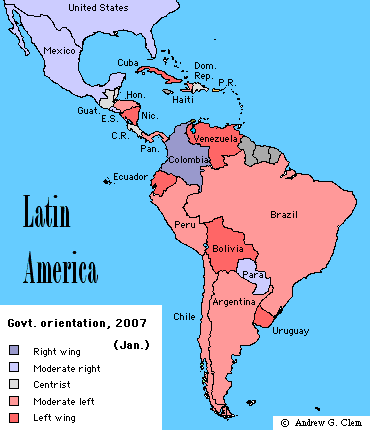January 25, 2007 [LINK / comment]
Latin America ideology maps
 As a fruit of my ongoing research, there is now a complete set of annual "government orientation" (as in ideology) maps on the Latin America Current Situation page, covering every year since 2000. Note that they refer to the president, not congress, so cases of divided government are not represented. In most of Latin America, the executive branch is much stronger than the legislative branch, so that is appropriate. It is remarkable that virtually the entire region has undergone a "reversal of polarity" since 2000. Four countries have remained quite steadfast, however: Mexico and Paraguay (both moderate right), Chile (moderate left), and Venezuela (far left). Ironically, there was also a reversal north of the border, but in the opposite direction!
As a fruit of my ongoing research, there is now a complete set of annual "government orientation" (as in ideology) maps on the Latin America Current Situation page, covering every year since 2000. Note that they refer to the president, not congress, so cases of divided government are not represented. In most of Latin America, the executive branch is much stronger than the legislative branch, so that is appropriate. It is remarkable that virtually the entire region has undergone a "reversal of polarity" since 2000. Four countries have remained quite steadfast, however: Mexico and Paraguay (both moderate right), Chile (moderate left), and Venezuela (far left). Ironically, there was also a reversal north of the border, but in the opposite direction!
Roll your mouse over this map to compare the ideological orientation of current governments with the orientations as of the year 2000.
A few discrepancies between these maps and information on the Latin America presidents (chronology) page have been resolved; that page has also been updated for 2007.
Uruguay vs. Argentina
The World Court has ruled in favor of Argentina in the dispute with Uruguay over the construction of a pulp mill along the Uruguay River which separates them. Environmental activists (including some NIMBYs, no doubt) have been putting up roadblocks near the town of Gualeguaychu to protest the pulp mill complex, which is owned by a Finnish company. The vote was 14 to 1, as the judges ruled that the economic harm caused by the roadblocks was not of a grievous nature. See CNN.com. The controversy first attracted world attention back in November 2005 (scroll down). The fact that the neighboring countries are at odds in spite of very similar cultural heritage and government orientation (left of center) illustrates that international conflict is more often rooted in clashes of national interest, rather than a clash of values.
Deadlock in Bolivia
Monday's Washington Post analyzed the political struggle in Bolivia, as President Evo Morales faces growing opposition to his proposed constitutional revision. The 255 members of the constituent assembly have been meeting for the last six months, but thus far they have not even resolved basic procedural issues. In the streets of Santa Cruz, Cochambamba, and other cities, meanwhile, demonstrations by radical supporters of Morales, and those who resist his agenda, have frequently turned violent. As in the case of Venezuela, high energy prices have provided a windfall for a government whose power is derived largely from its ability to deliver goods to poor people. This redistributionist agenda has sharply polarized the country, which has teetered on the brink of civil war in recent years.
Morales denied Tuesday that his government has any ties with the Basque separatist group ETA, but he did admit to meeting with some of their leaders. CNN.com